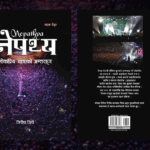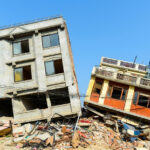A 2020 report by the Organisation for Economic Co-operation and Development (OECD) states that 53% of OECD countries that have active youth involvement and participation experience more democratic and sustainable policies being implemented. The report further expands on the role of youth groups and their potential to be harbingers of change, steering the country in a new direction. According to the Youth Vision 2025, a segment in Nepal’s ten-year strategic plan (2020/21-2030/31), and the Constitution of Nepal, youths are defined as being between the ages of 16 and 40 years. Even with a wide age group, the representation of youths in the Nepali parliament remains low at only 5%, while the global average representation of youths in politics stands at 13.5%. Furthermore, the legal age to contest in local-level elections is 21 years of age and to contest in provincial and federal elections, the individual must be 25 years old. These provisions further discourage youth from participating significantly in formal politics.
Back in 2008, when Nepal became a Federal Democratic Republic, Nepali youth’s participation was monumental in carrying out campaigns, resistance movements and demonstrations. The ‘People’s War’, the Madheshi and Adivasi Janajati movements, to name a few, witnessed impactful political activeness of the youth. These historic integrations of youth and politics in Nepal reflect the potential and intention of the youth as being key agents of change and nation-building. In fact, many of these movements were platforms for young Nepalis to build the current generation of political leaders. However, the representation of young people in political leadership positions still remains disproportionate. They continue to be utilized as assets that support and assist political movements and institutions instead of regarding them as active political leaders.
Although the policies guiding youth participation are still weak and political parties’ reluctance to formally engage youth is common in Nepal, the recent Nepal local-level elections, held in May 2022, saw a surge in youth involvement. The 2022 federal and provincial level elections too saw an increase in youth participation with 31% of the total candidates falling in the youth category. These paradigmatic instances have shown that the youth have the potential to drive change and bring new ideas to the table. However, it is crucial to understand the challenges that prevent them from taking on a more active role.
Youth Participation in the 2022 elections
During the local, provincial and federal elections in 2022, over 3 million young Nepalis were eligible to vote. During the local level election held on 13 May, the Election Commission of Nepal (ECN) stated that a gradual increase of over 41% of people’s representatives at the local levels or, 14,442 youths in total, were contesting from between 21 to 40 years of age group. The ECN also stated that from the youth category, 37 mayors, 95 deputy mayors, 106 rural municipality chairs and 234 vice-chairpersons were elected in the same election. Similarly, 2,312 youth ward chairs were elected in total.
In the same local elections, after experiencing the victory of independent candidate Balendra Shah for Kathmandu’s mayor, several youth-led campaigns marched the streets to encourage the public to vote for independent candidates instead of dominant parties.
Post the local elections, the federal and provincial elections of 20 November, revealed that there’s been an increase in youth participation by 32% and 31%, respectively as compared to the 2017 elections. Due to new, young politicians like Harka Raj Sampang Rai, Rabi Lamichhane, Dr Toshima Karki, and Sobita Gautam, the interests of the youth have been captured with the hope of restructuring the old institutions. Compared to previous polls, the number of youths filing candidacies for mayoral positions and ward positions increased by 3% and 4%, respectively. Instances like these were impossible in the past elections but due to the youth’s collective movement, the future of Nepal might see more young candidates emerging.
Challenges
Currently, the percentage of youth in Nepal stands at 40.68%, which means that the Nepali population has a youth bulge. A youthful population is regarded as a force of change and a source of innovation, and in Nepal, the youth has catalysed critical movements, systems and opportunities. Despite this bulge, the Nepali youth has been consistently met with employment obstacles and political discrimination that hinder their prospects to contribute and flourish. Some of the reasons are as follows –
Lack of employment opportunities
According to a 2015 report by International Labour Organization (ILO), the unemployment rate for Nepali youth is 19.2% compared to 2.7% for the entire whole population. Youth migrating abroad for work, education, and health facilities are some of the most notable reasons for the low participation of youth in formal politics. According to a 2014 report by the National Population and Housing Census, 1,475,692 youth (nearly 14% of the total youth) are abroad for employment and education. The reasons for this brain drain in Nepal is because of the lack of job opportunities, political instability, and the low salary system. Due to the mass exodus of youth leaving the country, Nepal is losing its highly-skilled workers and professionals to developed nations, in turn creating human capital flight.
Reluctance to integrate young politicians
An unwillingness of political leaders to hand over leadership and management roles to the younger ones has also been observed as a critical challenge. As of now, Nepal is being ruled by leaders who are in their 60s and 70s. Due to a lack of experience and professional guidance, young candidates often struggle early in their political careers. Across the world, the youth are given incentives and encouragement to participate in political and legal processes. For instance, the Lebanon government offers a Parliamentary Assembly of the Mediterranean Internship to graduates to partake in understanding public policy and learn about law-making. Similar immersive learning opportunities are offered in India, the UK and other countries that aim to integrate youth into legislative literacy and research. Nepal can draw learnings from such initiatives and extend the prospects of youth in the Nepali political landscape.
Tricky constitutional and legal provisions
Restrictive protocols in the legislation of Nepal prevent youths from contesting elections. A person must be 25 years old to contest in provincial and federal elections. The legal provisions of the country state that a person should be at least 45 years old or over to be a part of a constitutional committee. Since Nepal defines youth as an age group between 16-40 years, such a provision of only decreeing individuals to be over 45 years is discouraging and restraining, which needs to be restructured. Bureaucracy and legal provisions act as a barrier to youth representation from bringing new energy, ideas and visions into the policy discourse.
Exploring the full potential
The increasing number of youths in the second round of elections since the implementation of the 2015 Constitution shows changing dynamics within the Nepali political scenario. To ensure increased youth participation, a supportive environment with legal frameworks and plans for various electoral and parliamentary processes must be enabled so that the youth become equipped with decision-making and leadership skills. Similarly, youth policies and documents like the National Youth Policy need to clearly define youth and should consist of detailed and feasible action plans, timelines, and budgets for effective implementation. To utilize the full potential of Nepali youth, it is imperative to consider the youth population as active agents of change and vision leaders.
Krisha Shakya holds an MSc in International Affairs & Global Enterprise from the University of Utah and a MA in Development Studies from Kathmandu University. She is also the recipient of the Nepal Bidhya Bhusan Padak Award 2018. Her interests include international relations, economic development, sustainability, research, analysis, and information management. Currently, she is working as a Program Coordinator at NEF.





